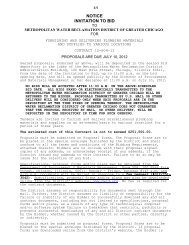Budget Message / Highlights - Metropolitan Water Reclamation ...
Budget Message / Highlights - Metropolitan Water Reclamation ...
Budget Message / Highlights - Metropolitan Water Reclamation ...
Create successful ePaper yourself
Turn your PDF publications into a flip-book with our unique Google optimized e-Paper software.
METROPOLITAN WATER RECLAMATION DISTRICT OF GREATER CHICAGO<br />
2009 BUDGET<br />
DESCRIPTION OF THE<br />
METROPOLITAN WATER RECLAMATION DISTRICT OF GREATER CHICAGO:<br />
ITS HISTORY, LOCATION, SIZE, POPULATION, AND TYPE OF GOVERNMENT<br />
District and History<br />
The <strong>Metropolitan</strong> <strong>Water</strong> <strong>Reclamation</strong> District of Greater<br />
Chicago (District) is an independent government and<br />
taxing body encompassing approximately 91 percent of<br />
the land area and 98 percent of the assessed valuation of<br />
Cook County, Illinois.<br />
The District is a separate legal entity sharing an<br />
overlapping tax base with the City of Chicago, the<br />
Chicago Board of Education, the Chicago School<br />
Finance Authority, the County of Cook, the Cook<br />
County Forest Preserve District, the Chicago Park<br />
District, the Chicago Public Building Commission, the<br />
Cook County Community College District, and various<br />
municipalities and school districts outside the City of<br />
Chicago but within the District’s boundaries.<br />
The District was originally organized as the Sanitary<br />
District of Chicago in 1889 under an act of the Illinois<br />
General Assembly which has been modified from time<br />
to time to increase the District’s authority and<br />
jurisdiction. The enabling act in 1889 was in direct<br />
response to a long standing problem with contamination<br />
of the water supply and nuisance conditions of the<br />
rivers. The District reversed the flow of the Chicago and<br />
Calumet River Systems to stop the discharge of sewage<br />
to Lake Michigan and instead, discharge it to the Des<br />
Plaines River, where it could be diluted as it flowed into<br />
the Illinois River and eventually the Mississippi River.<br />
Prior to the District’s construction of a 61.3 mile system<br />
of canals and waterway improvements, the Chicago and<br />
Calumet River Systems were tributary to Lake<br />
Michigan. These river systems are now tributary to the<br />
Illinois River system.<br />
From 1955 through 1988, the District was called The<br />
<strong>Metropolitan</strong> Sanitary District of Greater Chicago. In<br />
order to provide a more accurate perception of the<br />
District’s current functions and responsibilities, the name<br />
was changed effective, January 1, 1989, to <strong>Metropolitan</strong><br />
<strong>Water</strong> <strong>Reclamation</strong> District of Greater Chicago.<br />
Mission and Responsibilities<br />
The mission of the District is to protect the health and<br />
safety of the public in its service area, protect the<br />
quality of the water supply source (Lake Michigan),<br />
improve the quality of water in watercourses in its<br />
service area, protect businesses and homes from flood<br />
damages, and manage water as a vital resource for its<br />
service area.<br />
The District collects wastewater from municipalities in<br />
its service area, conveys it to wastewater reclamation<br />
plants, provides full secondary treatment and discharges<br />
clean water to local waterways. The District is also<br />
responsible for stormwater management for all of Cook<br />
County, including areas outside of the District’s<br />
corporate boundaries for wastewater services.<br />
Services<br />
The District’s seven modern water reclamation plants<br />
provide excellent treatment for residential and industrial<br />
wastewater, meeting permitted discharge limits virtually<br />
at all times. The treatment process is protected by a<br />
pretreatment program to guard against hazardous<br />
substances and toxic chemicals. These are strictly<br />
regulated pursuant to federal and state requirements.<br />
The District routinely monitors all industries and nonresidential<br />
sources to assure that wastes are disposed of<br />
in an environmentally responsible and lawful manner.<br />
Treated wastewater, along with runoff from rainfall,<br />
enters local canals, rivers and streams that serve as<br />
headwaters of the Illinois River system. Stormwater in<br />
the separate sewered area is controlled to reduce flood<br />
damages by a number of stormwater detention<br />
reservoirs. In the combined sewer area, the District’s<br />
tunnel and reservoir project has significantly reduced<br />
basement backup and overflows to local waterways.<br />
Flow within the District’s waterway system and the<br />
Lake Michigan discretionary diversion flow are<br />
controlled by three inlet structures on Lake Michigan:<br />
Wilmette Pumping Station, Chicago River Controlling<br />
Works and O’Brien Lock and Dam. The single outlet<br />
control structure is the Lockport Lock and Powerhouse.<br />
While exercising no direct control over wastewater<br />
collection systems owned and maintained by cities,<br />
villages, sewer districts and utilities, the District does<br />
control municipal sewer construction by permits outside<br />
the city of Chicago. It also owns a network of<br />
intercepting sewers to convey wastewater from the local<br />
collection systems to the water reclamation plants.<br />
Facilities<br />
The District is located primarily within the boundaries<br />
of Cook County, Illinois. The District serves an area of<br />
883.5 square miles which includes the City of Chicago<br />
and 125 suburban communities. The District serves an<br />
equivalent population of 10.35 million people; 5.25<br />
million real people, a commercial and industrial<br />
equivalent of 4.5 million people, and a combined sewer<br />
overflow equivalent of 0.6 million people. The<br />
District’s 554 miles of intercepting sewers and force<br />
mains range in size from 12 inches to 27 feet in<br />
diameter, and are fed by approximately 10,000 local<br />
sewer system connections.<br />
ii<br />
ii
















